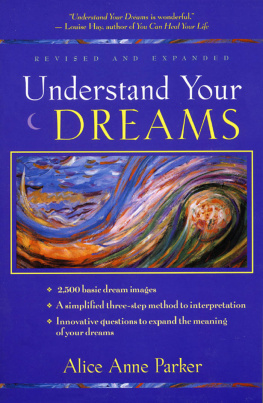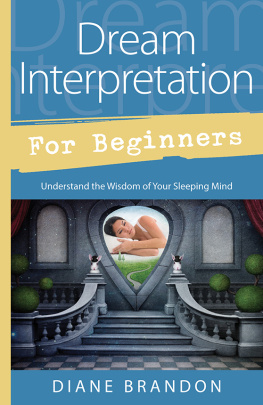Understanding Dreams and Other Spontaneous Images
Understanding Dreams and Other Spontaneous Images: The Invisible Storyteller applies a contemporary interdisciplinary approach to dream interpretation, bringing cognitive anthropology, folklore studies, affective neuroscience, and dynamic systems theory to bear on contemporary psychodynamic clinical practice. It provides a practical guide for working with dreams that can be used by both individuals on their own and therapists working with clients.
Erik D. Goodwyn invites us to examine key features of reported dreams, such as the qualities of the environment depicted, its familiarity or unfamiliarity, the nature of the characters encountered, and overall themes. This methodfacilitates an understanding of the dream in the full context of the dreamers life, rather than interpreting individual, isolated elements. Goodwyn also introduces the mental process which orchestrates dreams, conceptualised here as the Invisible Storyteller, and explores how understanding it can positively impact satisfaction in waking life. As a whole, the book provides a collection of tools and techniques which can be referred to time and again, as well as a wealth of examples.
Exploring dreams as a natural source of clinical insight, The Invisible Storyteller will appeal to Jungian psychotherapists and analytical psychologists, other professionals working with dreams with clients, and readers looking for a scientific approach to dream interpretation.
Erik D. Goodwyn is an assistant professor and director of psychotherapy training at the University of Louisville, USA. He has published on the dreams of soldiers in combat zones, on archetype theory and cognitive anthropology and folklore studies, on the psychology of rituals around the world, on combining depth psychology with symbolic anthropology, and the application of ritual theory to grief and mourning in clinical practice. His previous books include Healing Symbols in Psychotherapy: A Ritual Approach, The Neurobiology of the Gods, and, with Susan Greenwood, Magical Consciousness: An Anthropological and Neurobiological Approach (all Routledge).
Understanding Dreams and Other Spontaneous Images
The Invisible Storyteller
Erik D. Goodwyn

First published 2018
by Routledge
2 Park Square, Milton Park, Abingdon, Oxon OX14 4RN
and by Routledge
711 Third Avenue, New York, NY 10017
Routledge is an imprint of the Taylor & Francis Group, an informa business
2018 Erik D. Goodwyn
The right of Erik D. Goodwyn to be identified as author of this work has been asserted by him in accordance with sections 77 and 78 of the Copyright, Designs and Patents Act 1988.
All rights reserved. No part of this book may be reprinted or reproduced or utilised in any form or by any electronic, mechanical, or other means, now known or hereafter invented, including photocopying and recording, or in any information storage or retrieval system, without permission in writing from the publishers.
Trademark notice: Product or corporate names may be trademarks or registered trademarks, and are used only for identification and explanation without intent to infringe.
British Library Cataloguing in Publication Data
A catalogue record for this book is available from the British Library
Library of Congress Cataloging in Publication Data
Names: Goodwyn, Erik D., 1970- author.
Title: Understanding dreams and other spontaneous images : the invisible storyteller / Erik D. Goodwyn.
Description: New York : Routledge, 2018. | Includes bibliographical references.
Identifiers: LCCN 2018001608 (print) | LCCN 2018012064 (ebook) | ISBN 9781351252614 (Master e-book) | ISBN 9780815369349 (hardback) | ISBN 9780815369356 (pbk.)
Subjects: LCSH: Dreams. | Dream interpretation.
Classification: LCC BF1078 (ebook) | LCC BF1078 .G477 2018 (print) | DDC 154.6/3--dc23
LC record available at https://lccn.loc.gov/2018001608
ISBN: 978-0-815-36934-9 (hbk)
ISBN: 978-0-815-36935-6 (pbk)
ISBN: 978-1-351-25261-4 (ebk)
For Von
My inspiration
The light that brings me from dark seas incarnadine
And deserts of grey
To a valley of silver-green air
And mist covered groves
You make me possible
AML
In all of us, even in good men, there is a lawless wild beast nature which peers out in sleep.
Plato
The interpretation of dreams is the royal road to a knowledge of the unconscious activities of the mind.
(Freud 1900: 647)
The problem of bodies and minds
The idea that dreams are somehow meaningful and important is an extremely ancient one. What may be a surprise is the fact that dismissing dreams as meaningless is very old, too. Through the ages, the debate has continued, but ultimately the debate centers on the question of what the mind actually is. Is it a mere side-phenomenon of neural networks firing? Or does it have some fundamental reality to it that goes beyond cells and atoms?
Most simply, a dream is an experience. Everything else is interpretation. It is an experience of being in an environment, interacting with characters, with plot twists and turns, none of which is consciously created by the dreamer. Notice how that description could be used to describe the experience of waking life, also. But arent there differences? Or should we wonder if were all locked in the Matrix? Or being deluded by some malevolent demon? Descartes found out that pondering this question for any length of time leads one straight into what is known in philosophy as the mind-body problem. Put simply: how does the mind interact with the matter of your body (usually meaning the brain)? Is the mind created by the brain? If you think so, that is physicalism (or materialism). If, however, you think that the mind cannot be reduced to the workings of the brain alone, then you are a non-physicalist. There are many, many different versions of both of these, and an entire book could be written simply on this question, and many have.
But a full exploration of the mind-body problem is beyond the scope of what were talking about. For our purposes, it is only an important issue because many of the theories that attempt to explain (or explain away) dreams rest on physicalist assumptions that dreams are merely the workings of such-and-such (usually malfunctioning) brain mechanism and nothing more, with zero remainder. But this is simply not a settled matter. Thus, until that vaunted day when philosophers decide once and for all which philosophical position is true, however, we are going to have to work with what we have while trying to remain out of that quagmire. Therefore, the important things for our purposes are, what characteristics does the dream experience have? Can it teach us anything about ourselves, others, or life?
For ultimately, even if dreams are merely random neural firings and we are not finding but inventing meanings for them, those meanings can still cohere with our lived experience as conscious beings and enrich them. I, along with a significant number of others in the scholarly community do not think that dreams or the mind are reducible to whatever brain molecules bouncing around, but rather that when you have an extraordinarily complex, non-linear system such as the human brain and body, the behavior you get must be looked at holistically as well as reductively.











